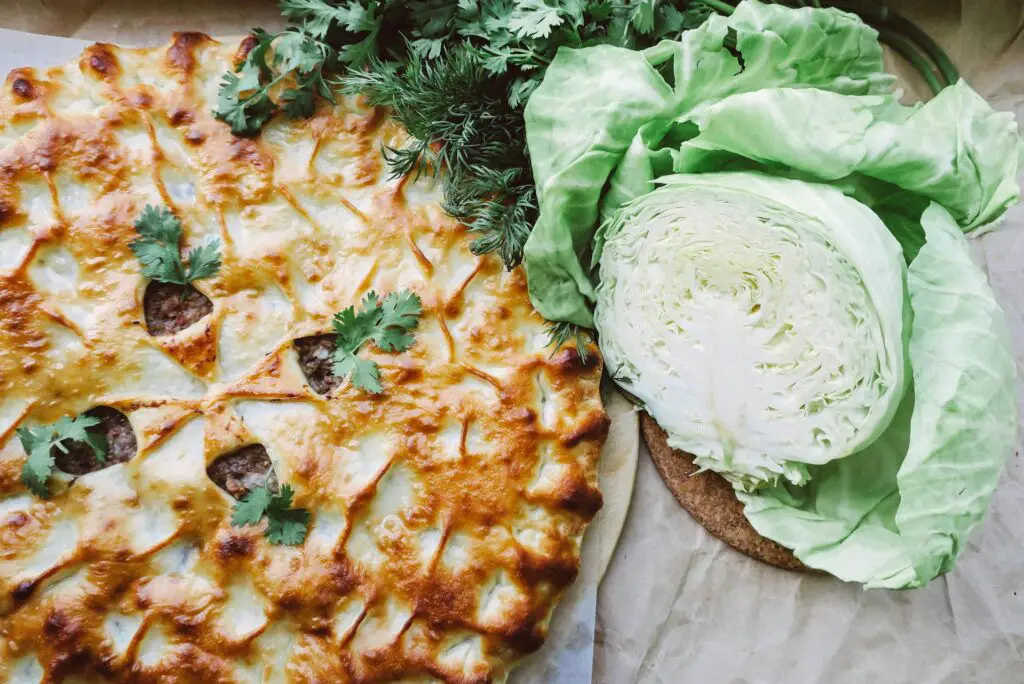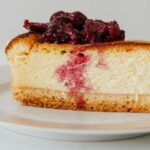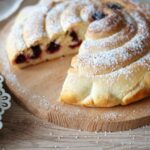Nothing ruins a good pie faster than a tough, soggy crust.
We’ve all been there—pressing our fork through what should be buttery layers, only to meet something bland and disappointing.
The truth is, flaky crust isn’t magic—it’s method. With the right steps, anyone can pull it off, no fancy skills required.
In this guide, I’ll show you how to get golden, tender layers that melt in your mouth every single time.
The Science of Flakiness
What Makes a Crust Flaky
Flakiness comes down to layers. When cold fat is cut into flour, you get little pockets of butter or shortening that stay intact.
As the pie bakes, the fat melts and the water inside it turns to steam. That steam pushes apart the layers of dough, leaving airy, crisp sheets that shatter with every bite.
The more defined your fat pieces are in the dough, the more distinct those layers will be once baked. That’s why “cold fat + gentle handling” is the golden rule.
Common Mistakes to Avoid
One of the biggest slip-ups is overworking the dough. The second you knead or mix too much, you activate gluten, and that means tough crust.
Another problem? Choosing the wrong fat or letting it get too warm. Warm butter just smears into the flour instead of holding its shape, and you lose the layering magic.
And then there’s water—too much and your dough turns sticky and heavy, too little and it crumbles before it even reaches the pan.
The sweet spot is adding just enough ice water for the dough to come together without turning gummy.
Flaky vs. Mealy Crust
Not every pie needs the same kind of crust. A flaky crust has those dramatic layers that work beautifully for fruit pies and sweet fillings—you want that light, crisp bite.
A mealy crust, on the other hand, happens when the fat is blended more completely into the flour, giving a sturdier, tender base.
That’s perfect for custard or cream pies where you don’t want the crust to absorb too much moisture.
Think of it like this: flaky crusts are the show-offs, while mealy crusts are the dependable workhorses. Both have their place—you just need to know when to use each.
Essential Ingredients
Flour
- All-Purpose Flour (2 ½ cups / 300 g)
- Most common choice, easy to find.
- Has moderate protein content, which means enough structure without being too tough.
- Pastry Flour (2 ½ cups / 300 g)
- Lower protein than all-purpose.
- Produces an even more tender, delicate crust.
- Great if you want a softer bite, but less forgiving for beginners.
Fat
- Unsalted Butter (1 cup / 225 g)
- Flavor powerhouse: gives that rich, buttery taste.
- Melts quickly, so keep it very cold.
- Creates distinct layers = maximum flakiness.
- Shortening (1 cup / 200 g)
- Neutral flavor, but excellent for structure.
- Holds its shape better than butter in warm kitchens.
- Yields a slightly less flavorful crust but very consistent results.
- Lard (1 cup / 200 g)
- Old-school favorite, unbeatable tenderness.
- Provides exceptional flake.
- Can have a mild pork flavor, so better for savory pies.
Liquid
- Ice Water (6–8 tablespoons / 90–120 ml)
- Keeps the fat cold, which is crucial for layering.
- Add gradually, 1 tablespoon at a time, until dough just comes together.
- Too much water = gummy dough. Too little = crumbly mess.
Salt & Sugar
- Salt (1 teaspoon)
- Enhances flavor and strengthens dough structure.
- Sugar (1 tablespoon, optional)
- Adds a touch of sweetness for fruit or dessert pies.
- Helps the crust brown more evenly in the oven.
Tools You’ll Need
Pastry Cutter, Food Processor, Rolling Pin
- Pastry Cutter
- Classic tool for cutting cold fat into flour.
- Keeps fat pieces intact without warming them with your hands.
- Food Processor
- Fast and efficient for blending dough.
- Be careful not to over-pulse—too fine a mixture means no flakes.
- Rolling Pin
- A sturdy wooden pin works best.
- Use steady, even pressure instead of pressing hard. This prevents tearing and keeps layers intact.
Why Cold Surfaces Help
- A chilled mixing bowl or rolling pin may sound extra, but it makes a difference.
- Cold tools keep butter or shortening firm, so they don’t smear into the flour.
- This ensures those precious fat pockets stay intact, which is what creates steam and flakiness in the oven.
Optional Helpers
- Silicone Mats
- Nonstick and easy to clean.
- Great for rolling out dough evenly without constant flour dusting.
- Pie Weights (or dried beans/rice)
- Essential for blind baking.
- They keep the crust from puffing or shrinking by weighing it down.
- Bench Scraper
- Handy for lifting and turning dough without stretching it.
- Also makes cleanup faster when flour scatters everywhere (because it will).
Step-by-Step Guide to Perfect Pie Dough
Step 1: Chill Ingredients and Tools
Cold is king when it comes to pie crust. Butter, shortening, or lard should go straight from the fridge (or even freezer) into the flour.
Your mixing bowl and rolling pin can join the chill party too. Cold tools and ingredients mean the fat won’t melt before baking, which is the secret to flaky layers.
Step 2: Mix Dry Ingredients
In a large bowl, whisk together flour, salt, and sugar (if using). This makes sure the seasonings are spread evenly throughout.
It’s a tiny step, but it prevents one bite from being salty and the next tasting plain. Think of it as setting the stage before the main act.
Step 3: Cut in Fat Until Pea-Sized Clumps Form
This is where the magic begins. Add your cold butter or fat into the flour and use a pastry cutter, fork, or your fingers to break it down.
Stop when you see a mix of coarse crumbs with little chunks about the size of peas. Those clumps are what create steam pockets in the oven.
Don’t overmix—you’re not making cookie dough.
Step 4: Sprinkle in Ice Water Gradually
Add ice water one tablespoon at a time, tossing gently with a fork after each addition. The goal is to add just enough so the dough holds together when pinched.
Too much water leads to a heavy, tough crust. Too little and it falls apart. Patience is your friend here—better to go slow than flood the dough.
Step 5: Bring Dough Together—Don’t Knead!
Once the dough starts clumping, use your hands to gently press it together. Resist the urge to knead like bread. Overworking activates gluten, and gluten is the enemy of tenderness.
Gather it just until it holds in a ball—messy edges are fine. Ugly dough often bakes into the prettiest crust.
Step 6: Shape into Discs and Chill
Divide the dough in half, flatten each piece into a round disc, and wrap in plastic wrap or parchment. Chill for at least an hour. Resting lets the gluten relax and keeps the fat cold.
When you roll it out later, you’ll thank yourself for this pause—it makes the dough pliable and prevents shrinking in the oven.
Rolling & Handling the Dough
Rolling out pie dough is less about muscle and more about finesse.
Start by lightly flouring your surface and rolling pin so nothing sticks, but don’t go overboard—too much flour toughens the crust.
Place the chilled disc in the center and roll from the middle outward, never back and forth, using steady pressure rather than heavy force.
After a couple of passes, lift the dough and rotate it a quarter turn, then roll again; this keeps the thickness even and the shape round without having to wrestle it back into place later.
If cracks sneak in around the edges, press them gently back together with your fingers or dab a little cold water as edible glue.
For bigger tears, patch with a scrap of dough and press lightly until it blends in—no one will ever know once the pie is filled and baked.
The goal is smooth, even dough that’s thin enough to bake through yet sturdy enough to cradle your filling, and with a little patience, you’ll get there without breaking a sweat (or your dough).
Blind Baking for Flakiness
When and Why to Pre-Bake
Blind baking simply means baking the crust before adding the filling. It’s a must for pies with wet or no-bake fillings like custard, cream, or pudding.
Pre-baking gives the crust a head start, so it doesn’t turn soggy when the filling is added.
Think of it as building a sturdy foundation before decorating the house—you want the base solid so everything on top holds up.
Using Pie Weights vs Beans
Once you line the pan with dough and parchment paper, you’ll need something heavy to keep the crust from puffing up.
That’s where pie weights come in. Ceramic or metal weights are reusable and distribute heat evenly.
No pie weights? No problem. A jar of dried beans or rice works just as well and can be reused over and over (just don’t cook them afterward).
The weight keeps the crust flat and helps it bake evenly across the bottom and sides.
How to Prevent Shrinking
Few things are more frustrating than a crust that slides down the pan while baking. To stop this, chill the lined pie shell for at least 30 minutes before it hits the oven.
Cold dough holds its shape much better against the heat. Pressing the parchment snugly into the corners and making sure the weights reach up the sides also helps.
Another trick: don’t stretch the dough to fit the pan when lining it—stretched dough always shrinks back. Treat it gently, let it rest, and it will stay put when baked.
Tips & Tricks for Consistent Results
Freeze Your Butter for Extra Flakiness
If you’ve ever struggled with butter melting too fast, freezing it first is a game-changer. Hard, icy butter holds its shape while you mix, creating bigger fat pockets in the dough.
Bigger pockets mean more steam in the oven, which means dramatic layers of flaky crust. Some bakers even grate frozen butter directly into the flour for perfectly distributed bits.
Add Vodka or Vinegar for Easier Rolling
Here’s a little baker’s secret: swap out a couple of tablespoons of water for cold vodka or add a teaspoon of vinegar.
Alcohol doesn’t activate gluten the way water does, so you can add enough liquid to bind the dough without making it tough. Vinegar, on the other hand, slightly weakens gluten strands.
Both tricks leave you with dough that rolls out like a dream and bakes up tender without sacrificing flakiness.
Resting Dough = Better Texture
Patience pays off here. Resting dough in the fridge after mixing allows the gluten to relax and the flour to hydrate evenly.
This makes the dough more pliable and less likely to shrink during baking. Even 30 minutes helps, but overnight is ideal if you have the time.
Think of it like giving your dough a nap—it wakes up easier to work with.
Keep Handling Minimal
The less you fuss with pie dough, the better it behaves. Over-handling warms the fat and toughens the crust by over-developing gluten.
Mix just until combined, roll only as much as you need, and fix cracks with gentle patches instead of re-rolling the whole thing.
The golden rule? Treat dough like a delicate friend—firm enough to guide, but gentle enough not to smother.
Troubleshooting Common Problems
Tough Crust → Overworked Dough
If your pie crust feels more like cardboard than pastry, chances are you overworked the dough. The more you mix and knead, the more gluten develops, and gluten equals chewiness.
The fix? Handle the dough as little as possible. Mix just until it comes together and let those rough edges be—imperfections often bake into flakiness.
Greasy Crust → Too Much Fat
A greasy, heavy crust usually means the fat-to-flour ratio was off or the butter got too warm before baking.
When fat melts into the flour instead of holding its shape, you lose the delicate layers and end up with a slick mess.
Use cold butter, measure carefully, and chill your dough before it hits the oven. That way, the fat melts at the right time—inside the oven, not on your counter.
Dry/Crumbly Dough → Not Enough Liquid
If your dough falls apart when you try to roll it, you probably skimped on the water.
Pie dough needs just enough moisture to hold together when pressed, but not so much that it turns sticky.
Add ice water slowly, a tablespoon at a time, until the dough clumps when pinched.
If you’re already mid-roll and it’s crumbling, a light mist of cold water on the surface can sometimes save it.
Shrinking Crust → Insufficient Chilling
A crust that pulls away from the pan as it bakes is a classic sign of rushing the chill time. Warm dough relaxes in the oven and shrinks back like an elastic band.
To avoid this, rest your shaped dough in the fridge for at least 30 minutes before baking. Even better, chill it overnight.
Cold dough holds its form, giving you those crisp edges and a crust that stays put.
Fun Variations
Herb or Cheese Crusts for Savory Pies
Why stop at plain when you can add flavor right into the crust? Fresh herbs like rosemary, thyme, or sage give savory pies a fragrant, earthy kick.
Just chop them finely and mix them into the flour before adding fat.
Want something bolder? Grated Parmesan or sharp cheddar can be folded into the dough for a crust that tastes as good as the filling.
Imagine a chicken pot pie wrapped in a cheddar crust—it’s comfort food on steroids.
Brown Sugar Crust for Sweet Fillings
For dessert pies, swapping a spoonful of white sugar for brown sugar changes the whole game.
Brown sugar brings a warm, caramel-like depth that pairs perfectly with apple, pumpkin, or pecan fillings.
It also helps the crust brown beautifully, adding a hint of crunch and sweetness.
The trick is to keep it balanced—too much sugar makes the dough sticky, so stick to one or two tablespoons.
Whole Wheat or Alternative Flours for a Rustic Twist
If you want a heartier, more rustic crust, whole wheat flour is your friend. It brings a nutty flavor and darker color, though it can make the dough a bit denser.
To keep it tender, use a mix of half whole wheat and half all-purpose. Feeling adventurous? Try spelt, rye, or even gluten-free blends.
Each one gives the crust its own character, like a little signature on your pie. It’s a simple way to make a classic recipe feel brand new.
Final Words
Flaky pie crust isn’t complicated—it’s just cold ingredients and a light touch. The less you mess with it, the better it turns out.
Like any skill, it gets easier the more you practice. Each crust teaches you something new.
So grab your favorite filling, roll out a batch, and give it a try. Then share your masterpiece—I’d love to see how it turns out!
FAQs
Can I make pie dough ahead of time?
Yes! Pie dough can be made up to 3 days in advance if wrapped tightly and kept in the fridge. Just let it rest on the counter for a few minutes before rolling so it’s easier to handle.
Can I freeze pie crust?
Absolutely. Wrap discs of dough well in plastic and freeze for up to 3 months. Thaw overnight in the fridge before rolling out.
You can also freeze a fully lined pie pan for quick, ready-to-bake crusts.
Is butter better than shortening?
Butter gives unbeatable flavor and crisp layers, while shortening offers extra stability and tenderness. Many bakers use a mix of both to get the best of each world.
Why does my crust shrink?
Shrinkage usually comes from stretching the dough to fit the pan or skipping chill time. Always press the dough gently into place and chill it before baking to help it hold its shape.
Do I need a food processor?
Not at all. A pastry cutter, fork, or even your fingers will do the job. A food processor is faster, but the risk of overmixing is higher, so beginners often get better results by hand.



